- REMEMBRANCE FLAG
- See memorial flag 2).
- REPEATING FRIGATES
- The 18th Century term, now obsolete, for those frigates that were stationed outside or behind the
main line in a fleet of sailing warships in order to relay flag signals to ships out of view of the
flagship (see also flagship and
signal flag).
Please note that in the context of the above definition a
frigate was a naval vessel which carried her main armament of 28 50 guns on a single deck.
- RESERVE ENSIGN
- See under ensign.
- RESPECTANT
- See appendix V
- RETREAT CEREMONY
- In military usage, a formal ceremony requiring a full guard and band for lowering
the national flag at the end of the day on special occasions (see also
reveille and
sunset).
Please note that this ceremony has its roots in
late Medieval and early Renaissance period with the formal ceremonies associated
with closing the gates of fortresses and castles for the night.
- REVEILLE
- In UK, US and some other military usage, the ceremony of hoisting the national
flag at the start of a day and taken from the name of the bugle call sounded to
awaken the troops (see also 'colours 5)' and
'retreat ceremony').
- REVERSE
- The less important side of a flag that is generally, but not invariably, a
mirror image of the obverse. A distinctive reverse design or charge will
usually only be found on unique flags, ceremonial flags, regimental colours
and similar, there are however, occasional exceptions - see
'double-sided' and
'two-sided'.(also
ceremonial flag 1).
colour 2),
obverse
and unique flag).
- REVERSED
- 1) On flags, the term is used to refer to a charge or charges that run in the opposite
direction to that in which they are normally placed (see also
reversed chevron,
reversed pall and
reversed pile).
- 2) In heraldry, as above but the term is also used when arms or a charge are reversed or turned downward
debased, everted, inverted, subverted, subvertant or transposed.
- REVERSED CHEVRON
- See chevron.
- REVERSED PALL
- See 'pall'.
- REVERSED PILE
- See pile.
- REVERSED TRIANGLE
- See triangle.
- RHOMBUS
- See lozenge.
- RIBBON SCROLL
- 1) Generically, see scroll.
- 2) Specifically, the term used for a narrow ribbon in the form of a scroll but of
greater length than is usual); it is normally (but not exclusively) placed below and/or
around the shield in a set of armorial bearings or an emblem, and is generally inscribed
with a motto for example, those on the flags of the US states of Iowa and Massachusetts
(see also scroll).


Flag of the State of Iowa, US; Flag of the State of Massachusetts, US (fotw)
- RIKSBANNER (or RIJKSVAANDEL)
- See coronation flags.
- RING
- 1) A charge in the form of a narrow circular band typically used to separate
a suns central disc from its rays, as in the flags of Macedonia and Taiwan - a torus (see
also disc and
cartouche).
- 2) A piece of wood or metal for attaching a windsock to its pole and for keeping
it open (see also windsock).
- 3) See battalion ring and
battle honour.
- 4) One of a number of circular metal bands used as an increasingly (but
not entirely) obsolete method of attaching a military colour, parade flag or
gonfalon to its staff - see colour 2),
parade flag 2) with its following
notes and gonfalon 2).
Please note that the heraldic term for this type
of charge is an annulet, but we suggest that a suitable glossary or heraldic dictionary
be consulted for its correct usage.


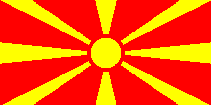
Naval Jack of Taiwan (fotw); National Flag of Macedonia (fotw)
- RISING
- See appendix V.
- RISING DIAGONAL
- See ascending diagonal.
- ROD OF ASCLEPIUS
- See Staff of Asclepius.
- ROGACINA
- In Middle European heraldic usage, the Polish term for a charge in the form of a stylized
arrowhead or spear point, often with a decorated shaft and generally (but not invariably) pointing
upward (see also shafted and
barbed).
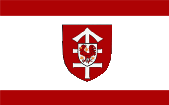




Ceremonial Flag and Arms of Cieszkσw, Poland (fotw); Flag of Baranσw, Poland (Jarig Bakker):
Arms and Flag of Ropczyce-Sedziszow, Poland (fotw)
- ROPE GROMMET
- See grommet 3).
- ROUNDED FLY
- See lanceolate
- ROUNDED SWALLOWTAIL
- See descate.
- ROUNDEL
- 1) A circular emblem of nationality employed on military aircraft and
Air Force flags, generally (but not exclusively) consisting of concentric rings
of the national colours and based on the cockade (see also
aircraft marking(s),
cockade 2),
fin flash and
national colours 2).
See supplemental note
- 2) A non-circular emblem of nationality employed by some nations in the same way
and for the same purpose as 1) above for example that of the United States and of
The Philippines.
- 3) A heraldic term for a disc, particularly (but not exclusively) one that
is a colour rather than a metal - see disc
(also bezant and
plates).



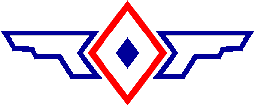
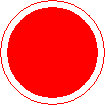


From left: Aircraft roundels: Argentina; Belgium; Colombia; The Philippines. Japan (fotw);
Example; flag of Apples, Switzerland (fotw)
Please note with regard to 3) that in strict English heraldic
usage this term should only be employed when the charge described is a colour not a metal (see
tinctures in appendix III).
- ROYAL COMMAND FLAG (or BANNER)
- In Swedish usage, a banner of the royal arms (thus differing from the normal Swedish royal
standard) and flown in the presence of His Majesty the King when attending military functions,
or when acting in his honorary capacity as commander in chief of Swedens armed forces (see
also banner 1) and
royal standard(s) 1)).
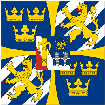
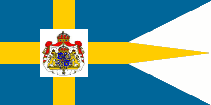
Royal Command Flag, Sweden (fotw): Royal Standard, Sweden (fotw)
- ROWEL
- See star 2).
- ROYAL BANNER
- See royal standard 1) and following note..
- ROYAL COLOUR (or COLOR)
- See colour 2) and
colours 2).
- ROYAL PLATE
- In British Royal Naval usage and some others, the royal equivalent of a flag disc
and used on boats in place of the appropriate royal standard when full ceremonial is
not required (see also flag disc and royal standard below).
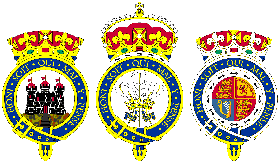
From left: The Plates of The Duke of Edinburgh; The Prince of Wales
and of Other Members of the Royal Family, UK (Graham Bartram)
Please note that in British Royal Navy usage a boat with Her Majesty The Queen on board never carries
a royal plate, but always flies the royal standard which requires full ceremonial.
- ROYAL STANDARD(S)
- 1) That flag, frequently a banner of arms, which signifies the presence and/or
authority of the monarch (see also banner 1),
personal flag 1) and
presidential standard but
see note below).
- 2) In the plural, a term sometimes applied to the flags flown by other members
of a royal family the queens, crown princes standard etc.
- 3) In UK military usage, the official name of the state colour of the Grenadier
Guards but see state colour 2).
![[royal flags]](../images/v/vxt-d275.gif)
From left: UK Royal Standard (Martin Grieve); Denmark Royal
Standard (fotw); Crown Princes Standard, Japan (fotw)
Please note that this term has been defined in 1) above according
to current UK usage, but should, strictly speaking, only be applied to Royal Standards of the
heraldic pattern as detailed herein under
standard 3) and
standard 4), and the term Royal Banner employed where more
appropriate (see also banner 1)).

The Heraldic Standard of King Richard III of England (fotw)
- ROYAL TRESSURE
- See double-tressure.
- RUDDER STRIPES
- See fin flash.
- RULE OF TINCTURE
- Most authoritative sources agree that good flag design should obey the heraldic
Rule of Tincture, and it is therefore stated in brief here: A colour should never
be placed on a colour or a metal (that is silver and gold in heraldry and generally
white and yellow in flags) on a metal. Metal may, however, be placed on colour
and colour on metal. It is, none the less, strongly suggested that those more
deeply interested in this subject should refer to the entries on tinctures,
metal and fur given in Appendix III, and to consult
a dictionary of heraldry for a more complete description.
- RULES OF ETIQUETTE
- The rules governing flag etiquette (or the protocol governing flag usage)
vary slightly from country to country, but are stated briefly in
Appendix II (see also
flag code,
flag etiquette,
flag law and
precedence).
- RULES OF RESPECT
- The rules that govern respect for the national flag may be summed up in a
Golden Rule, which simply stated says that the national flag should be treated
with respect at all times. The particulars of what exactly this respect entails
vary in detail, legal status and extent, from country to country, however, the
general principles remain the same and a full list is given in
Appendix II.
- RUNNING EYE AND TOGGLE
- A traditional method, of hoisting a flag much favoured in European countries,
whereby a rope is sewn into the heading fitted with a wooden toggle at the top
and a loop or eye splice at the bottom that fastens them to their opposites on
the halyard toggle and becket (see also
becket,
eyesplice,
hoistline,
and toggle).




















![[royal flags]](../images/v/vxt-d275.gif)

